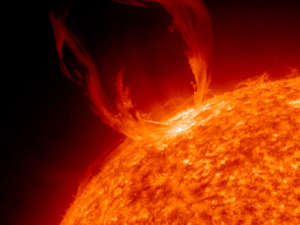One of the most important questions our species has tackled is the origin of life on Earth. If we can figure out the conditions and catalyst for the beginning of life, we can look elsewhere in the universe for those same conditions, and zero in on the potential for finding extraterrestrial life. We know the universe is old enough for the painstakingly slow evolutionary process, but what started it?

In the famous 1952 Miller-Urey experiment, a flask containing the basic natural elements water (H20), methane (CH4), Ammonia (NH4), and Hydrogen (H2), all present on the early Earth, was subjected to high voltage spurts of electricity, essentially simulating lightning. When they analyzed the results, the flask was found to contain several amino acids, organic compounds that are required for life. A recent analysis of the original mixture, sealed since the experiment, revealed over 20 amino acids in the mix. So to make the organic compounds for life from inorganic molecules, you need energy, and lots of it.
The modern problem is how to get Ammonia, and specifically Nitrogen, into the mix. Ancient bacteria figured out how to split up N2 to make Ammonia and other usable nitrates, but before they existed, how did we get Ammonia? Nitrogen in the early Earth was in the stable form N2, the same gas that makes up 78% of our atmosphere today. So the question is, how do we get enough energy to split up Nitrogen gas so it can react with other elements to produce nitrates such as Ammonia?
Another problem arose in 1972, when Carl Sagan and George Mullen realized a paradox. There is evidence that when the Earth was young, about 4 Billion years ago, it had liquid water. But there is also evidence that the Sun was about 70% as hot as it is today, meaning the Earth received less sunlight, and would have been significantly cooler. There must be something that warmed the ancient Earth. The leading hypothesis is that there was an abundance of greenhouse gases in the atmosphere, such as N2, Methane, and Carbon Dioxide. But even though these warm the Earth, there is still no production of useable Nitrogen.
In a paper released in the journal Nature Geoscience, a team of researchers from NASA’s Goddard Space Flight Center are proposing a solution to both of these problems. The ancient Sun, albeit cooler, was much more magnetically active, producing regular ‘superflares’ that would release huge swaths of radiation in all directions. When these superflares hit the Earth, they compressed the magnetosphere and broke though to the atmosphere. The energetic radiation could break apart molecules in the atmosphere with ease, including Nitrogen, which could go on to form Ammonia and the other nitrates. This same energy could go on to produce amino acids in the way lightning did in the Miller-Urey experiment.
As for the warming of the early Earth, they propose that the N2, Methane, and CO2 greenhouse gases in the early atmosphere were split apart by the same intense solar radiation, and so they couldn’t be causing the warming. Instead, Nitrous Oxide (NO2) would be produced in the same process, which is a greenhouse gas 300 times as potent as Carbon Dioxide. This would warm the early Earth even with a cooler Sun. It could also lend an explanation as to why Mars, even further from the Sun, had liquid water in the past.
It also has implications for planets that exist around young stars, bringing those beyond the ‘habitable zone’ back into the mix for producing life. It gives exoplanet scientists another degree of freedom as they look for evidence of extraterrestrial life using the next generation of telescopes.
Ultimately, the search for life and its origins requires a deep understanding of multiple sciences, and the collaboration of researchers across the globe. As humanity digs deeper and comes closer to an answer, in the back of my mind I always remember an important saying: “Extraordinary claims require extraordinary evidence.” We’ll see, hopefully sooner than later, what extraordinary evidence comes to light.

This site is the best